
Chances are, you were still in nappies or not yet walking around the globe when the first email was sent. That was in 1971. Around 1995, sending emails became more popular as the Internet became more accessible to the general public. The connections were still a bit rusty and the landline was unreachable if you checked your mail. Also, we did not yet know email marketing in its current form.
Given the volatility of online platforms at the time, it’s pretty impressive that email marketing is still such an important medium. And although social media platforms and new targeting possibilities are mushrooming 🍄 there is only one platform where you communicate so specifically with your (potential) customer. Email marketing is far from dead. ☠️
The end of email marketing is nowhere in sight. Every year, companies increase their budgets to get more out of this tool. In a recent study by Marketingprofs, 37% of the respondents indicated they will increase their budget for email marketing in 2022. It is the most effective, results-oriented and relatively inexpensive marketing tool and offers many opportunities.
With this guide, we explain what email marketing is, what you can do with it, which software tools are the best choice and how you can use it optimally to grow your organisation and get more out of your potential and existing customers.
What is email marketing?
Email marketing is a form of direct communication with prospects and customers with the aim of informing, maintaining and strengthening the relationship, stimulating purchases or increasing retention.
Email marketing can vary from sending a periodic newsletter to inform, to a complete email marketing tunnel to realise more sales. Various email software allows you to create, schedule and analyse the emails afterwards. Every open, click and purchase is registered, so you can calculate exactly what email marketing yields.
The benefits of email marketing
1. Low costs
Cheap is expensive. If you do not want to invest in marketing, you will see it in your results. Nevertheless, email marketing is a low-threshold means of communicating one-to-one with your customers and leads. You invest once in a good email programme, set aside enough time to create the basis and from there you can continuously attract leads and customers.
2. It is easy to learn
If you want to advertise in search engines or score organically, you need certain knowledge to make sure you become successful. The advantage of email marketing is that anyone can send an email. Do you find it difficult to create a nice template or is writing strong texts not your thing? Then outsource that. But anyone can plan, develop funnels and analyse the results. By creating mailings over and over again and by seeing what works, you will become a lot better at it.
3. The right message at the right time
Do you still send your marketing emails with everyone in the BCC? Clumsy and not necessary. With the right email software, you can automatically send the right emails at the right time. For instance, you schedule the newsletter for a specific moment, the reminder mail is sent when the recipient has not opened the first mail or the download is sent after an interested party has filled out your form. Most email software offers the possibility to build funnels so that the right message is sent at the right time.
4. Personalize your message with the right data
Chances are that your organisation has not one but several target groups. For example, take a shoe shop that sells men’s, women’s and children’s shoes. This way, you send the offer (e.g. women’s shoes) only to women. The chance of conversion will therefore increase enormously.
5. The CPC is generally lower, while the CTR and conversions are higher
Email marketing is the most effective marketing channel. That is, if you use it properly. You probably recognise it: you’re scrolling through your overflowing social media timeline and one advertisement after another flies past you. You probably don’t even notice it, because you have a lot of stimuli to process.
In the inbox of your email program, you are in control. You decide which newsletters are interesting and which you want to unsubscribe from. This creates more peace and quiet and allows you to pay full attention to emails that you do find interesting. If the sender gets it right, the message will be in line with your wishes and therefore the chance of conversion will be higher than on other channels.
6. Your message in your own style
If you choose for an email software such as ActiveCampaign, Mailchimp or ConvertKit, you can design your email in the style you like. In these and other email software, you can make your message jump off the screen with the drag-and-drop editors.

7. Address your reader directly
You’ve been with us for a year, Marcel. We celebrate this with a present in this mail!
We like to be addressed personally. That is the advantage of email: not only can you choose when your email is sent, to which person and with which message, but you can also personalize it IN the email. Based on all the data you have (e.g. name, date of birth, gender), you can address this person. In addition, you can also personalize the content of the message.
All fields from the CRM database or from the emailing list can in principle be used in emailings to address the recipient personally. This makes email marketing more personal and in many cases increases the degree to which the email is opened, read, and clicked through.
An example of personalization in email marketing:
Dear Mr. Jansen (<-variable),
Because organisations in the wholesale sector (<variable) are facing increasing pressure on margins, we have an interesting offer for Handelsbedrijf Jansen B.V. (<variable) […].
In this example, both the own name, branch and company name are loaded from the database in order to make the online mailing as specific as possible and thus increase the chance of scoring. Emailmarketing is a essential part for Account Based Marketing tactics.
8. Autoresponder
Another advantage of email marketing is that you can set up automatic mailings that are sent out when the prospect/customer performs a certain action.
An example:
- A website visitor downloads a white paper and leaves an email address in exchange. In doing so, he also gives permission to receive the email newsletter. The visitor immediately receives an email containing a link to the white paper.
- A few days later, the visitor receives another email that elaborates on the white paper and offers an additional piece of content. The visitor clicks on the link in the email. The visitor then receives another online mailing with more information about that topic.
- After a week, the visitor (if no action has been taken yet) receives an invitation for a meeting with one of the new business sales employees.
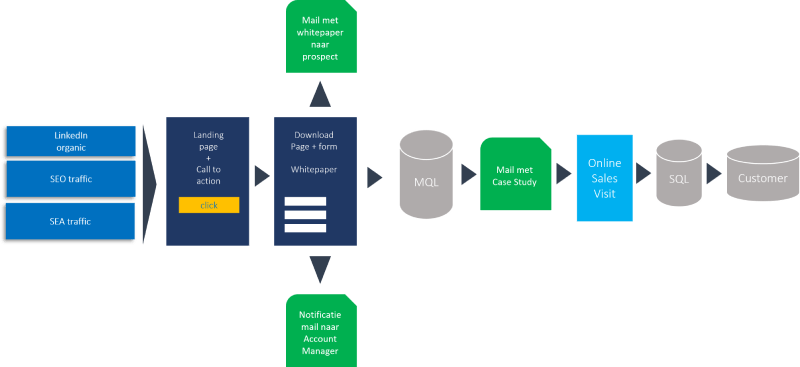
All the online mailings from this example of the benefits of email marketing are preset autoresponders.
9. Easily measure your results
Today’s b2b marketer is under a lot of pressure and needs to provide insights into budget spending and campaign results. Email marketing offers excellent possibilities to provide insight into the results of campaigns. With reasonable accuracy, statements can be made about the number of opened mails, the number of clicks, etc. Moreover, response rates are displayed quickly, giving you almost instant insight into the return on investment of your mailing. In relation to traditional media, email marketing is easy to measure.
- What percentage of your database has opened your emails?
- Who clicked through?
- How many quotations were requested as a result of the email?
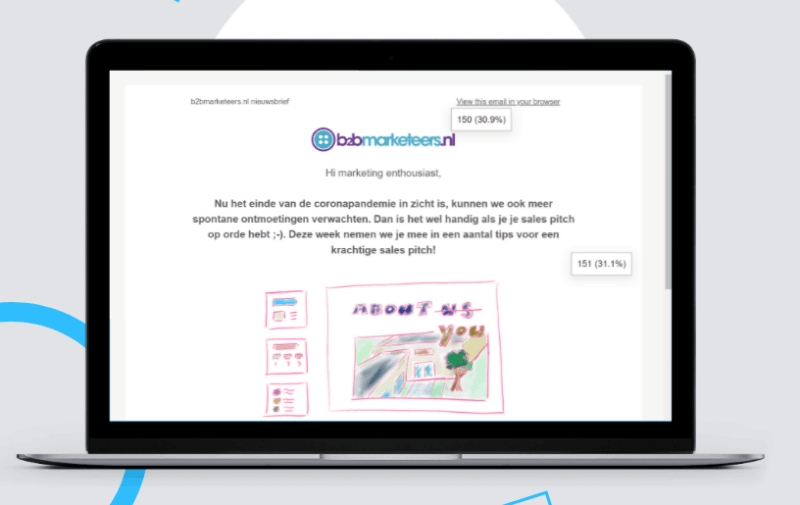
These and other data are easy to view. Based on this, you can also take follow-up actions. Have many people opened your emails, for example, but nobody clicked through? Maybe the button was too low on the page or you want to use a different call to action.
Email marketing software
Sending automatic emails, tapping into your inner designer and analysing data as if you have never done anything else. With the right email software, it’s a higher maths, but daily business. Today, you can use email marketing software to build your marketing funnels. We list our favourites.
HubSpot
Inbound marketing is synonymous with HubSpot. The platform offers all the tools necessary for marketing, sales and service to work together optimally. HubSpot is the originator of the term ‘inbound marketing’ and is a suitable tool for large organisations that have fully mastered this principle. Linking with other software tools is not necessary: HubSpot’s ‘hubs’ work seamlessly with each other and make other software tools such as your own CRM or CMS superfluous. But integrations are possible if you wish. HubSpot is particularly suitable for larger organisations that are more advanced in marketing.
Check our Hubspot review here
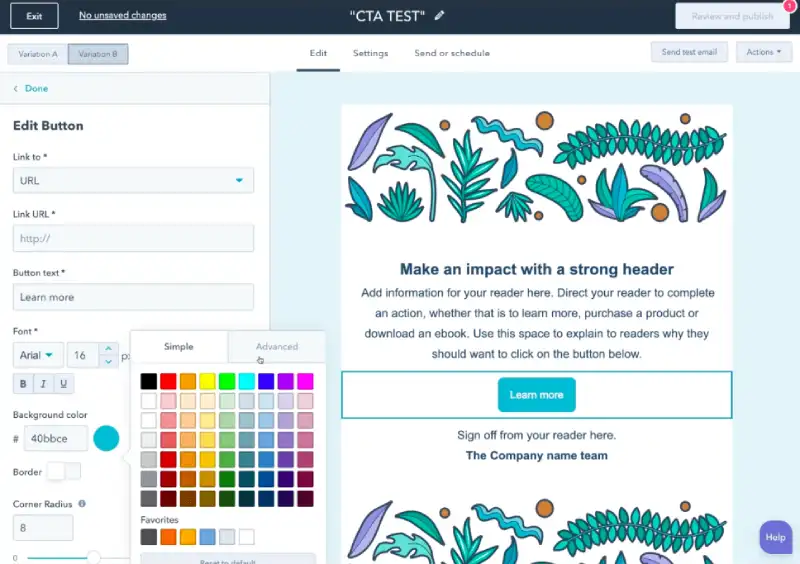
ActiveCampaign
ActiveCampaign is one of the fastest growing email marketing tools. Not bad, because the possibilities are endless and the price is nice. You can design personal emails, create forms and make clear funnels. It is also a suitable CRM: with tags, lists and personal contact fields, you can store all the user data you need.
From about 100 euro per year, you can use these extensive functionalities and adapt your marketing message to your audience. ActiveCampaign is mainly meant for SMEs, but because of its small price, it is also a perfect tool for self-employed people. Because of the extensive automation possibilities, we also see many large organizations using the program. Besides that you have local ActiveCampaign resellers. They are certified partners and offer support in your own language.
Check out our ActiveCampaign review
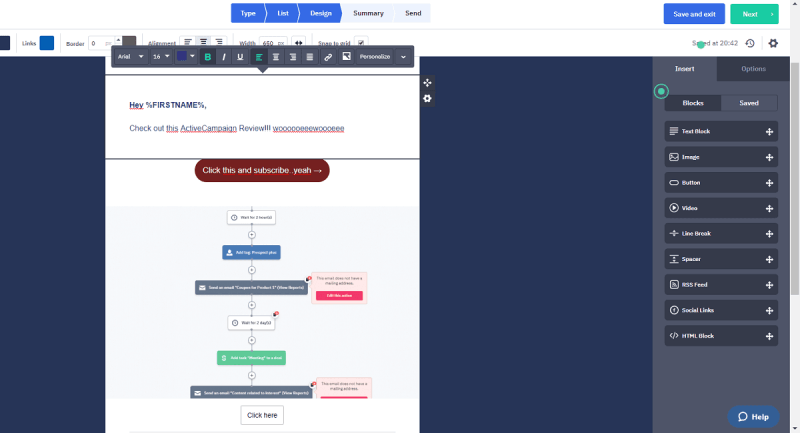
MailerLite
Looking for an affordable alternative to tools like Mailchimp or ActiveCampaign? Then you might want to consider Mailerlite. This user-friendly email marketing tool gives you plenty of options at a very friendly price.
Read our Mailerlite review
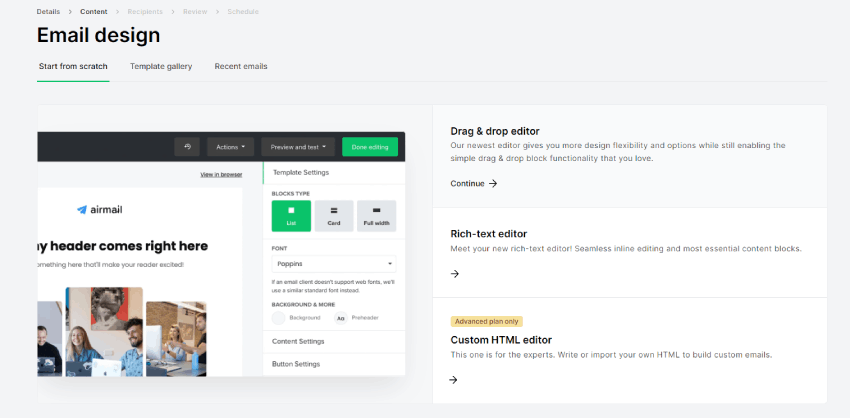
ConvertKit
With ConvertKit, email marketing is a breeze. Compared to other tools you need less technical knowledge. The mail editor is simple and clear. You can also easily set up workflows and campaigns. The disadvantage of this tool is that you do not have an email list, as you only work with tags. From 30 euro per month, you can set up your email marketing strategy in ConvertKit. This tool is especially popular with freelancers, online creators, musicians, and other entrepreneurs in the creative sector.
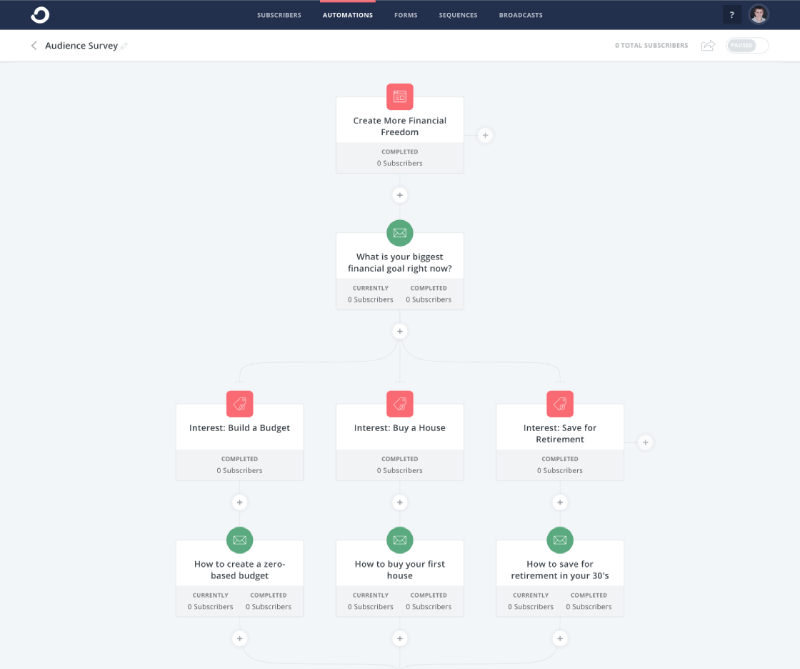
Spotler
Spotler (formerly Mailplus) is a Dutch company focused on marketing automation. With this software you can create newsletters, set up automatic campaigns and create landing pages. In recent years the interface has been improved, but compared to ActiveCampaign it is a bit more cumbersome. However, Spotler’s development power is great and they make great leaps.

MailChimp
Probably MailChimp has few secrets for you. Every self-respecting marketer has used it at some time or another: the most stripped-down version is free and offers links to websites and shops.
MailChimp has undergone some improvements in recent years, allowing you to set up simple automations and edit forms more easily. Ideal for the starter in the field of email marketing. If you really want to develop your email strategy and make it a part of your marketing machine, you better choose tools like ActiveCampaign, HubSpot or ConvertKit.
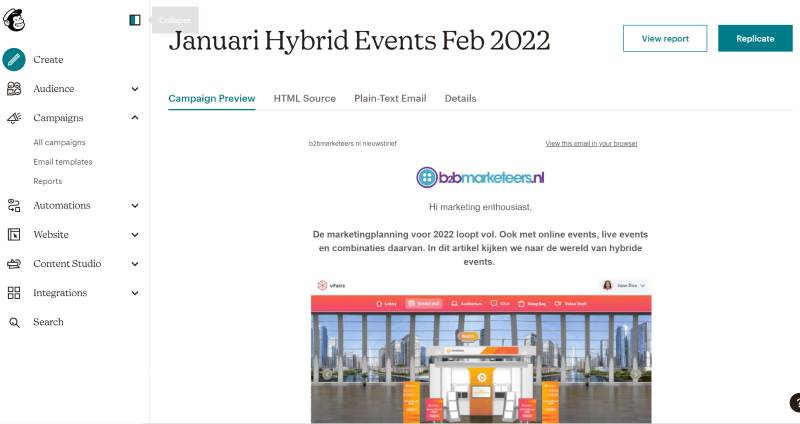
Flodesk
A frustration of many email marketers: upgrading for extra subscribers. As if you are punished when you attract more subscribers. Not at Flodesk: you pay one fixed price (38 US Dollars per month or 418 US Dollars annually) for unlimited possibilities. No packages, no hassle. Ideal for the organisation that wants to grow in the field of email marketing and wants to create dazzling emails. The Flodesk editor offers perhaps the most possibilities to make your emails splash. You also have integration options with Shopify, Zapier, Facebook and WordPress, among others.

Enormail
Enormail is a Dutch company that helps you grow your business in the field of email marketing. The software works intuitively and you can easily automate, personalise and link with other programmes such as your CRM or webshop. From 12.50 per month you can use this tool.
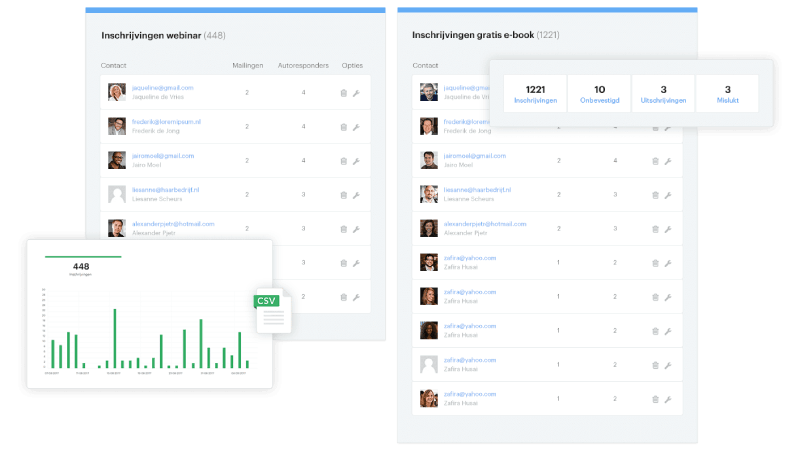
Copernica
Compernica is one of the largest Dutch players in the field of email marketing. Besides the standard functionalities such as an email editor and marketing automation possibilities, you can also make complex connections with their Rest API and Webhook. Adjusting the message in one email based on the target group? It is possible with dynamic content. You have to dig a little deeper though: from 225 euros per month, you can use this. A good tool for organisations that are already a step ahead in the field of email marketing.
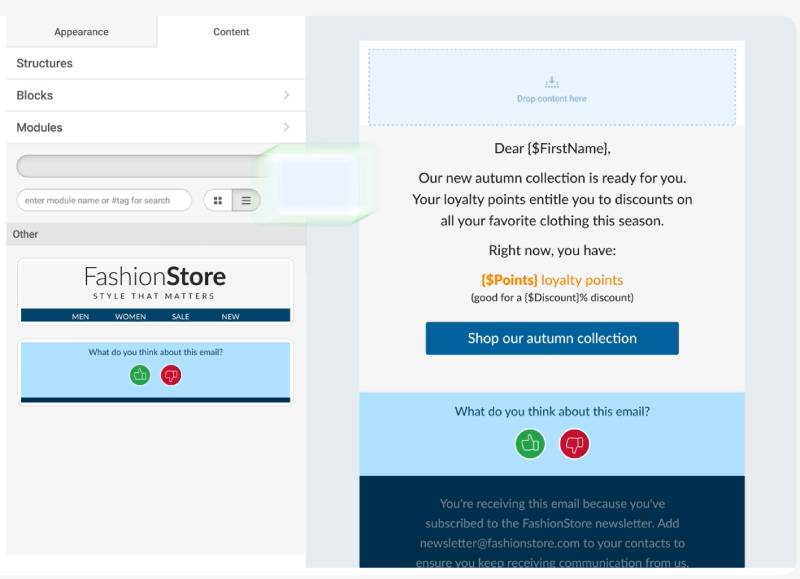
Email marketing for B2B & B2C
Whether it concerns B2B or B2C customers, setting up a rock-solid strategy is the first step. Before you start email marketing, you want to formulate the goal: why are you setting up email marketing and who do you want to reach?
Based on that, you open a plan that depends on more than just the type of customer. Still, in general, there are a few differences:
Email marketing for B2B:
Knowledge and expertise are important
Often decisions take longer to convert, email is therefore an important tool to build and strengthen the relationship
The goal is often to generate leads instead of completing purchases
Method of working: offering whitepapers, masterclasses and downloads combined with sharing tips by email (on a weekly basis) to eventually make an offer
Email marketing for B2C:
The purchases are often more fleeting
The aim is usually to make a purchase in a web shop
Method: build a personal relationship and mail the customer at important moments (birthdays) Offer a personalized offer and add urgency (countdowns) to the mails
Email & Privacy
Email marketing and privacy legislation go hand in hand. You may remember the spring of June 2018, when your inbox was bulging with desperate requests from organisations to please send you emails. Many had not received an explicit opt-in from you, even though that is one of the main pillars of the tightened law.
Personal data for email marketing
With email marketing, you collect personal data and that is only allowed if the user explicitly gives permission. Automatically sending the newsletter to customers who have bought something but have not signed up for the newsletter, is not allowed. This is all laid down in the AVG (General Data Processing Regulation).
The email programs mentioned above all have the possibility to let you do email marketing within the framework of the law. But before you start mailing haphazardly all the people on a stray excel sheet, it is smart to think of a strategy first. This not only ensures that you play it safe, but also that the quality of your email database improves. Quality is more profitable than quantity.
Integration with other systems
Lately, we see more and more integration between email marketing tools and other software tools such as CRM software. We also see email tools that allow marketers to set up complete campaigns with variable content based on the respondent’s preferences.
Integrating email marketing software with other systems creates interesting possibilities for personalisation (as described earlier). Tools like Pipedrive or Salesforce are known for their integrations.
Check our Pipedrive review and Salesforce review here.
But also the analysis of the success of mailings can be enhanced. Think for instance of a link between an email marketing package and Google Analytics. By making this link, clicks on landing pages with an origin of specific mailings can be seen.
💡Tip! Find CRM systems that connect with your email marketing software.
How to choose the right email software?
With the proliferation of different email marketing software, you might not be able to see the wood for the trees. How do you choose the right programme? Before you randomly choose the first, best program, make a list of your needs and wishes.
1. What is the purpose of email marketing?
The focus of your activities largely determines the software you need. Are you going to use the tool mainly to mail existing customers? Are you looking for something for the internal newsletter to employees? Or are you looking for a complete Marketing Automation solution for setting up new business funnels? The answer to these questions is of great importance in selecting the most suitable tool.
2. What type of organization do you work for?
Are you a creative freelancer who uses your newsletter to sell digital tools and training courses? Then tools like Convertkit or Mailchimp might suit you. Are you a large top 500 organisation looking for an email tool to set up webinar funnels, event invitations, prospect and customer mailings? Then tools like HubSpot might be a better choice.
3 Will you do it yourself, or will you work with a partner (or agency)?
It is different for each organization how they handle the operational process of email marketing. You can outsource the whole process. There are also organizations that prepare everything themselves and only outsource the final touches. You can also work with partners for the development of funnels or the coding of cool email templates.
4. How many subscribers does your current email list have?
Many tools work with a cost structure that is linked to the number of subscribers to the newsletter. This can add up considerably in terms of costs. When choosing a tool, therefore, also look at this component within the cost structure. Two questions are important here:
- how pure is the current database (do you want to pay for all those emails that are sent to ‘bad’ email addresses?
- How fast do you expect to see growth in the number of subscribers?
5. Is it a local agency and is support in your language important to you?
For many organizations, it is important that software in the operation and support is native-speaking. A local partner who you can speak to in your own language can be pragmatic when things need to be adjusted quickly, for example. There are also reasons for choosing a local tool that has to do with the storage of crm-data. Does your company have a data policy that requires data to be stored in the same country? Then you can select the right email marketing software for you.
6. Are links to other software tools needed?
This question is a little misleading. Links with other tools are almost always needed. An email tool is simply much more powerful if it is an extension of your CRM, for example. Or if it links to your website. These are also the most obvious links. Your ambition, marketing maturity and current IT landscape determine which links are relevant.
Most email marketing tools have APIs available with the most common software such as ERP and CRM. Connections are also often possible through parties such as Zapier or customization can be delivered.
7. What is your budget?
We have already discussed the cost structures of email marketing software providers. They use different models. Some common price elements among email marketing providers:
- a fixed amount per user per month
- a variable amount (tier) for the number of emails per month or
- a variable amount for the number of email addresses
- a fixed amount per month for support or
- a variable amount for support
Because email marketing is an essential part of the marketing machine for many companies, it is customary to set aside a large budget for it. In many cases you need it; email marketing software is not always very cheap. There are good business cases to justify the cost of your email tool.
For e-commerce companies that can activate product sales through the email newsletter, this kind of calculation is easy. For a b2b consultancy, this can be more difficult. In that case, you could start from the number of leads you expect to realize through the use of email marketing (webinar registrations for example).
Test and learn
Once you have answered these questions, you can start a targeted search for the right email software. Most tools allow you to create a free trial account to test the software. Ask those around you about their experiences so that you can better determine which program is best for you.
How do you get started with email marketing?
Email marketing is more than just sending the occasional email to your (dormant) database. If you want to get results from it, you need a rock-solid strategy. Here’s how to do it:
- Determine your goal (reactivate sleeping customers, generate new leads or maintain the relationship)
- Determine your KPIs (conversion ratio, CTR, opens).
- Review your current policy and remove inactive contacts
- Create lists and design forms based on your goals
- Design templates for your emails
- Create a campaign depending on your goal
- Draw up your email flow with the different scenarios worked out
- Create emails
Are you ready to start with email marketing? Get started right away with our ActiveCampaign review!
Frequently asked questions about email marketing
Email marketing is a form of direct communication with prospects and customers with the aim of informing, maintaining, and strengthening the relationship, stimulating purchases, and increasing retention.
Service e-mails: Think of confirmation e-mails after you have signed up for a newsletter or the e-mail that your order is on its way.
Newsletter mails: Periodic mails at a fixed moment, for which the subscriber has specifically opted in.
Event-based e-mails: This is also called marketing automation. Emails are not sent at a fixed moment, but based on behavior and events. An autoresponder containing the downloaded e-book, a birthday mail sent to the recipient on the right day or an automatic appointment reminder.
In marketing automation, recurring tasks are automated across multiple channels. Often, e-mail plays an important role in this because customer-specific data is stored and enriched in the CRM/e-mail software.
Check out our top 3 CRM solutions for this month
Recommended Reading
The importance of creativity in B2B marketing: the relationship between innovation and growth
The importance of creativity in b2b marketing is often underrated. With this article i show the benefits of creative marketing!
6 Key CRM KPI’s every business should track (with examples)
6 Key CRM KPIs every business should track. Read everything about CRM KPIs and how to be successful using them
9 crm selection pitfalls and tips
There are a number of pitfalls lurking with a CRM selection. Avoid plunging into the CRM cloud unprepared!
AI and CRM: how artificial intelligence is reshaping the future of customer relationship management
AI and CRM: How artificial intelligence is reshaping the future: relationship management is never going to be the same
What is Demand Generation? The Real Story!
What is Demand Generation? The Real Story! Check out the defenition of demand generation and how we see this in relation to b2b marketing!
Essential CRM data for every business
But what you may not know is that your CRM data can actually be a valuable asset for your business. How do you keep your data up to date?
